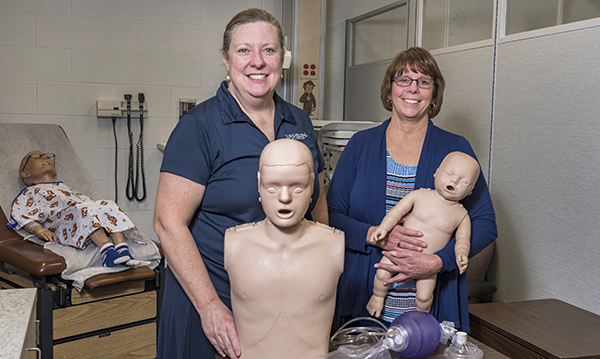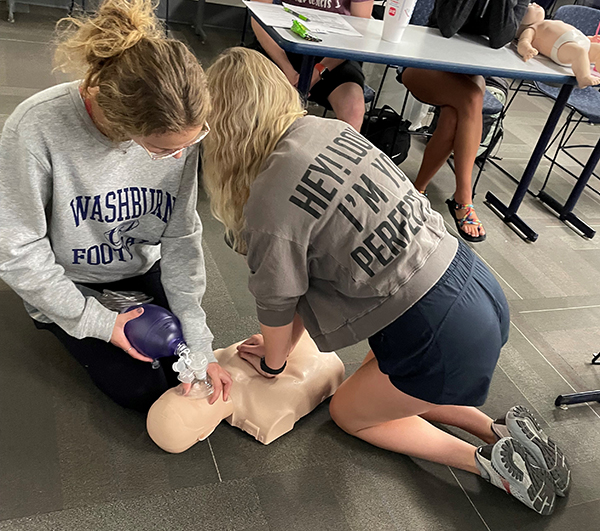Improved Care
New training lets nursing students better treat child patients in danger

School of Nursing faculty Amy White, msn ’14 (left), and Belinda Eckert, bsn ’86, stand with mannequins and equipment used to provide PEARS training. Photo by Jeremy Wangler
From The Ichabod - Winter 2023
By Angela Lutz
Working as a nurse requires quick thinking and immediate action – particularly when pediatric patients are involved. For Washburn University School of Nursing student Corinn Searcy, receiving PEARS – pediatric emergency assessment, recognition and stabilization – training as part of her nursing school curriculum has already proven beneficial. She had a kid code – go into cardiac arrest – during a clinical.
“To be able to go through the PEARS training beforehand was helpful because we had never worked in pediatrics before,” Searcy said. “It set us up for success with knowing what to do and what to expect.”
Washburn began teaching PEARS concepts as part of their pediatric course in 2021 after receiving grant funding from Washburn Women’s Venture Partners. Amy White, msn '14, assistant professor and director of simulation, wrote the grant proposal for PEARS after noticing some gaps in her students’ knowledge.
“I recognized during pediatric simulations with the students we were missing some key concepts related to emergencies, like how to recognize when a child is in danger,” White said. “Kids are very poor communicators, and they won’t tell you, ‘I feel funny. I can’t breathe’ – they’ll just stop breathing. This class helps people recognize some of those symptoms.”
Working with Assistant Professors Caren Dick, bsn '84, and Belinda Eckert, bsn '86, White utilized her knowledge as a certified PEARS instructor at the University of Kansas Health System St. Francis Campus to create an abbreviated version of the course for Washburn students. The training comprises a full day, with lectures in the morning and hands-on demonstrations and simulations in the afternoons. Content focuses on how to immediately assess a pediatric patient’s status and take appropriate action if they are in distress.
“It’s a nursing life skill that’s going to benefit them down the road,” White said. “When these new graduate nurses are at the hospital, they are thrown into all kinds of situations, and it can be overwhelming. Introducing these concepts in nursing school makes some of these situations less scary and intimidating.”
The hands-on portion of the training has been particularly well received by students. Eckert said simulations have become an essential part of nursing education, so students have embraced the opportunity to apply their academic knowledge in practical ways.
“PEARS training makes students stronger nurses because they’ve had exposure to the content and they’ve been able to practice the physical skills that go along with that,” Eckert said. “They know what a child in distress looks like, so in the real world they don’t have to think so hard about what they’re going to do, they can jump right into action.”
For the simulations in particular, White said grant funding has been vital, as this is where the concepts students learned in class begin to make sense in a real-world context.
“Without the funding we would not have been able to do any of the simulations,” she said. “It allowed us to implement the hands-on portion – which given what we know from the pedagogy of learning and nursing, simulations are where the students put it all together. Without the hands-on portion, we doubt it would have been as effective as it has been in helping the students understand these concepts.”
The PEARS training also helps future nurses feel more self-assured and ready to act in emergency situations. Searcy recently completed her capstone rotations at Children’s Mercy Kansas City, and after her graduation in December she will begin working as a nurse in the mother-baby unit at the University of Kansas Medical Center. She said the PEARS training has given her a different perspective she will carry with her into her future career.
“Knowing what signs to look for beforehand is very helpful so you’re not freaking out in the situation,” she said. “It has given me a different mindset to notice if something with a patient is changing or escalating.”
The timing of the training is also intentional, with students receiving PEARS instruction the semester before they graduate, even if they aren’t planning to become a pediatric nurse. While the chances of them needing to intervene in an emergency as student nurses is not as high, they will need to be ready to take swift, decisive action in their nursing careers.

“We get them right before graduation. It’s their last semester,” Eckert said. “Within several months of having the training, many of those students are out there working as nurses, and this training helps them feel more confident and prepared.”
“Most nursing students wanted to be nurses to help people,” White said. “This is one more way for them to do that.”